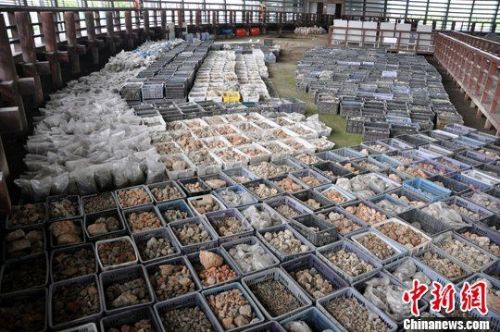 |
|
File photo of the cultural relics unearthed from the Tianluoshan site. [Photo/chinanews.com] |
Sleeping on a cool grass mat to evade the summer heat was a pleasure understood by Chinese people 7,000 years ago.
A team of scientists have identified a nearly 7,000-year-old reed mat discovered in east China, offering a rare glimpse into a very early stage of the civilization's textile making.
Objects such as baskets woven from plants are among the oldest human technologies. Their origin is believed to be related to the rise of agriculture, which fueled the need for grain and seed containers. Yet a lack of surviving items has long hampered studies.
According to an article published in the journal Scientific Reports, Zhang Jianping and his colleagues dated the remains of a woven mat unearthed at a Neolithic settlement site in Tianluoshan, Zhejiang province, and put its age between 6,645 and 6,775 years, the oldest woven object to be discovered and dated in China.
It is more than 2,000 years older than silk textiles from Qianshanyang in Zhejiang province and 1,000 years older than the Kudzu fabric from Caoxieshan in Jiangsu Province, the article said.
The yellow textile piece is 50 cm long, 20-40 cm wide with a thickness of 0.2 cm. Judging from its flat shape and a lack of grain residue detected on it, it was more likely used as a mat, rather than a food container, Zhang, with the Chinese Academy of Sciences, told Xinhua.
"Our guess is that our ancestors used it as a cover or bedding," Zhang said in an email interview. "Its exact use is open to discussion."
By examining its phytoliths (a microscopic structure found in rotten plants), Zhang's team concluded the mat was made of reeds, rather than bamboo or bulrush, all commonly used in mats in ancient and modern-day China.
Items made of plants are prone to decay after being buried, which explains why many ancient weaves were only identified by their imprints on other items, but Zhang said the mat was luckily placed in an oxygen-free environment filled with underground water that helped it survive.
The study could shed light on how reeds and other plants were woven into the daily life of Chinese predecessors 7,000 years ago, while offering a new approach for identifying ancient weaving, Zhang said.
|
|
|
|
|
|
|
|
